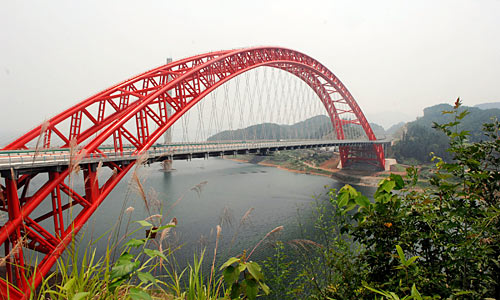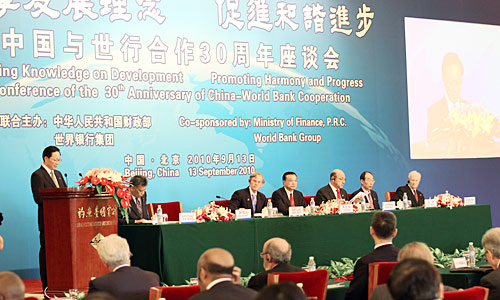|
 |
|
RED BRIDGE, GREEN PROJECT: The World Bank-financed Anhui Tongling-Huangshan Highway features environment-friendly construction and protection of plant life along the way (WANG LEI) |
This year marks the 30th anniversary of the China-World Bank Group partnership, a major component of the country's roaring economic machine.
While China gleams with vibrant economic growth and significant poverty reduction, the World Bank is recognized for its active supporting role in the country's development. By June 30, 2010, the World Bank's cumulative lending commitments to China had exceeded $47.41 billion for a total of 323 projects involving transportation, energy efficiency, urban construction and environmental protection. In its latest move, the World Bank extended financing of $4.788 million to help reduce rural and agricultural pollution in the East China Sea.
But, loans aside, knowledge has proved to be the most important aspect of the partnership as the bank has been sharing development experiences, management expertise and cutting-edge technologies with China, customizing them to the country's needs.
By any measure, the arrangement has been fruitful. In the past three decades, China has the highest success rate for World Bank projects and is now firing ahead economically while developed economies falter.
In addition, China's poverty rate fell sharply to 10 percent in 2004 from 65 percent in 1981. Since 1995, the bank has disbursed around $800 million in credit to China's poverty alleviation projects, benefiting more than 8.7 million poor residents in central and west China, said He Xiaojun, Deputy Director of the International Poverty Reduction Center in China.
"The key to the success of the China-World Bank cooperation is the country's remarkable ability to utilize global knowledge and expertise of the World Bank to move its own reforms forward," said World Bank President Robert Zoellick at a press conference on September 16 in Beijing. This was his fourth official trip to China since he took office as the bank's chief in July 2007.
"The bank's financial and management prowess has allowed China to gain strength and laid the groundwork for the country's economic takeoff," said Xie Xuren, Minister of Finance of China.
Joining forces
The seed of the partnership was planted in April 1980 when then Chinese Vice Premier Deng Xiaoping and World Bank President Robert McNamara first met in Beijing.
"We are poor, and we have lost touch with the world," Deng told McNamara. "We need the help of the World Bank to catch up."
But Deng couldn't have imagined how the World Bank would come to embrace China, let alone the fact China would one day become a donor instead of a debtor nation.
 |
|
JOINING HANDS: The Ministry of Finance and the World Bank Group co-sponsored a conference on September 13 to mark the 30th anniversary of the partnership. Robert Zoellick (third left), China's Vice Premier Li Keqiang (fourth left) and Minister of Finance Xie Xuren (first left)attended the conference (COURTESY OF WORLD BANK) |
In the early years, China looked to the bank for project financing, technical assistance, as well as management methodologies. When it helped build the Lubuge Hydropower Station in southwestern Yunnan Province in 1984, the World Bank introduced the system of international bidding for large civil projects in China. Before this, government contracts were mostly awarded through direct contracting, without any competition. The Lubuge project demonstrated impressive cost saving and quality improvements, and as a result the bidding system began to find wider use in the country.
Like many other enduring ties, the China-World Bank partnership has evolved with time. As the projects in China developed, the learning became mutual.
"The World Bank has learned from the ways China fine-tuned its projects," said Zoellick. "These are achievements that have not only benefited China but also the East Asia region more widely and even the world."
Since 2005, around 70 percent of World Bank activities in China have had an environmental objective as the country has embarked on the road of a green economy. Besides this, around 70 percent of the bank's loans for China went to underdeveloped northeastern and western regions in a bid to help bridge the geographic wealth gap.
| 